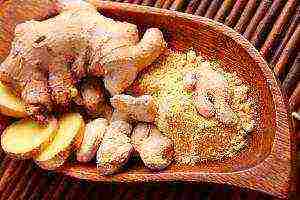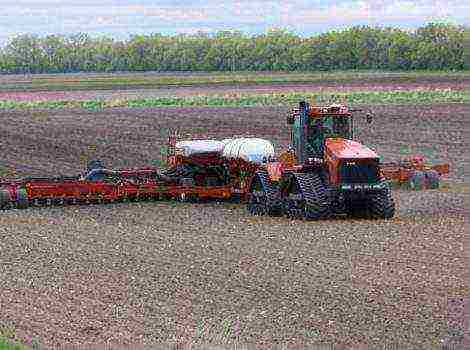Content
- 1 Conditions required for large-leaved hydrangea
- 2 Planting large-leaved hydrangeas
- 3 Large-leaved hydrangea care
- 4 Wintering large-leaved hydrangea
- 5 Pest and disease control of large-leaved hydrangea
- 6 Hydrangea planting rules
- 7 Basic rules for caring for hydrangea
- 8 Propagation of hydrangea
- 9 Popular types of hydrangea
- 9.1 Large-leaved hydrangea (Hydrangea macrophylla)
- 9.2 Hydrangea paniculata (Hydrangea paniculata)
- 9.3 Stalked hydrangea (Hydrangea petiolaris)
- 9.4 Hydrangea tree (Hydrangea arborescens)
- 9.5 Ground cover hydrangea (Hydrangea heteromalla)
- 9.6 Recommendations for planting and caring for hydrangea in the garden - video
- 10 Large-leaved hydrangea: planting and care in pots
- 11 Large-leaved hydrangea in the open field
Garden or large-leaved hydrangea is a gorgeous shrub in every sense. Despite the fact that this plant is initially not very hardy, the fashion for it has embraced our gardens as well. The magnificent caps of the inflorescences with unique shades of color, the luxurious leaves and silhouettes of this queen among the hydrangas are enchanting. And only after planting a bush or two of large-leaved hydrangea in their garden, many gardeners discover all the "pitfalls". This hydrangea, the most difficult to grow, requires systemic care and attention, the most careful selection of conditions and is generally quite capricious.
Large-leaved hydrangea (Hydrangea macrophylla)
Large-leaved hydrangea, or garden (Hydrangea macrophylla) is a highly decorative and fast-growing species of hydrangeas native to Japan and China. The maximum height in a region with severe winters is limited to 1-2 m.This species has erect shoots, ovoid, large, bright green leaves and flat wide inflorescence shields up to 15 cm in diameter and up to 10 cm in height, consisting of fruiting lilac or blue and large pink, with irregular bright strokes, reaching up to 3.5 cm in diameter, sterile flowers. Hydrangea inflorescences, the flowering of which starts in July, remain highly decorative until next spring: they dry out, but still remain very attractive.
Large-leaved hydrangeas, the fashion for which came to us from the West, so captivating in tubs and pots, so unique in their beauty for their almost spherical dense inflorescences and bright foliage - shrubs are still capricious and unadapted to the harsh climate. But this does not prevent them from growing even in regions with harsh winters. And although these beauties need special care and protection for the winter, their beauty, nevertheless, is unmatched. And it doesn't matter if you decide to transplant a potted hydrangea into the garden or originally purchased a garden plant - the principles of growing and caring for the shrub will still be the same. The main difficulty in growing large-leaved hydrangeas is associated with the need to preserve last year's shoots, on which this type of hydrangea blooms, during a long and harsh winter, not only without freezing, but also without damping off.
Choosing the right variety is a key success factor in growing large-leaved hydrangeas. This plant has more winter-hardy and less hardy varieties that can only winter indoors. The declared frost resistance of this type of hydrangea is up to -18 degrees, typical only for varieties adapted to the harsh climate and mainly modern ones. When choosing hydrangeas, you should give preference to plants not according to the degree of their decorativeness, but according to the factor of adaptability to your climate - the plants of local garden centers and nurseries. Imported large-leaved hydrangeas are more likely to cause disappointment. Be sure to check if the variety has been tested in your area or is grown in a climate similar to yours. When choosing a variety, it is worth paying attention to one more very important factor: remontability or common cultivar.Repairing varieties, to which the vast majority of modern macrophylls belong, are hydrangeas, which can boast not only a variety of colors, but also the ability to bloom both on last year's and on young shoots. Such hydrangeas are guaranteed to bloom: even if something fails or winter protection is not enough, young branches will still give at least a few inflorescences.
Hydrangea macrophylla is grown differently from other types of hydrangeas, including treelike and paniculate. If other species have much more in common than excellent in the requirements for care and selection of conditions, then the large-leaved hydrangea requires a special approach to itself. Large-leaved hydrangeas should only be bought in containers or pots: seedlings with an open root system do not take root well and should not even be experimented with in regions with harsh winters (injuries sustained by the root system will not allow the plant to fully adapt and grow the root system sufficient for to withstand the winter even with shelter).
Large-leaved hydrangea (Hydrangea macrophylla)
Conditions required for large-leaved hydrangea
Despite the status of shade-tolerant shrubs, inherent in all hydrangeas without exception, macrophylls do not belong to such. Even in southern regions with mild winters, this plant can be planted only in partial shade, and not in the shade, and in regions with severe winters, plants should be classified as light-loving. But when choosing a place for a large-leaved hydrangea, you should not rush to plant it on hot sunny areas, protecting it from midday and lunch rays. So that the large-leaved hydrangea does not suffer from heat and overheating of the roots, the plants are planted in a place where they will not be illuminated by the daytime, but by the morning or evening sun (but not less than 6 hours a day). Ordinary sunny areas will lead to the fact that in summer the leaves and inflorescences of the bush will wither and wither every day, and the latter may not recover even at night.
When choosing a place, it is worth considering the location in relation to trees and shrubs. Despite the fact that in most landscape projects hydrangeas can be seen under the trees, planting macrophylls in such a company is still not a good idea. Hydrangea is moisture-loving and under woody ones it can suffer from a lack of moisture, which will be pulled from the ground by giants.
Large-leaved hydrangea (Hydrangea macrophylla)
Planting large-leaved hydrangeas
Planting macrophylls requires great care and careful preparation. The main attention should be paid to the preparation of the site and the soil mixture, which will be filled with the planting pit.
The optimal planting time in regions with severe winters (including in the middle lane) is spring. Planting hydrangeas is carried out as soon as the weather permits, the soil will not only thaw, but also warm up, and the threat of severe frosts will pass.
For large-leaved hydrangea, the recommended planting distance is about 1 m.
Hydrangea is not simply covered with soil removed during the digging of a hole, but a special soil mixture is prepared in which the roots adapt and germinate faster. Peat, humus, coniferous soil are added to the garden soil in equal shares, preparing a loose and super nutritious soil mixture. The garden soil removed from the hole, in turn, can be replaced with a mixture in equal proportions of sod, leafy soil and sand. But the key point is to determine the acidity of the soil, which, in turn, will provide the color of the inflorescences. If you want to grow those very blue, blue or purple hydrangeas (you can get them only from varieties with a pink or red color, but not from white-flowered hydrangeas), then you need to prepare in advance such a soil that will provide the original high acidity. For blue hydrangeas, the pH should be between 5.0 and 5.5.For hydrangeas with white, pink and red inflorescences, the permissible value is from 6.0 to 6.2 (in acidic soil, the color of non-white varieties will change to lilac or blue). In any case, large-leaved hydrangeas should not be planted in soil with a calcareous reaction (maximum permissible pH value is 6.4). If you want to get blue or lilac colors, then you need to add aluminum sulfate to the soil. At the same time, if the soil is changed specifically to obtain blue hydrangeas, it must be remembered that such an addition is only the first step. In the future, it will be possible to save the colors only with proper watering and fertilization. In addition to the acidifying additive, a full portion of complex mineral fertilizers is also applied to the soil. Today, the addition of hydrogel has become fashionable, which allows you to more effectively retain moisture.
The size of the planting pit should correspond to the size of the root ball of a large-leaved hydrangea: about 35 cm deep and wide for small bushes in small containers and half-meter holes for larger specimens. Preparing the landing pit will also require additional tweaks. To avoid the risk of water stagnation even on ordinary clay soils, improve water and air permeability, create an optimal environment at the bottom of the planting pits, you need to lay a drainage layer (expanded clay or pebbles, but not crushed stone).
Before planting, the upper free layer of the substrate is carefully removed from the container (usually it is quite dirty), and the plant is watered abundantly for at least a few hours. When taking out a hydrangea, you need to be very careful and try not to destroy the earthen lump. In a cramped container or pot, strong young roots tend to curl around the perimeter of the earthen coma, as if entangling the substrate. They need to be straightened, straightened carefully, without injuring the small roots. A thin layer of soil is poured at the bottom of the hole and a small mound is created. A hydrangea is placed on it, straightening long roots. Then the seedling is carefully covered with the prepared soil mixture, carefully tamping the soil and gently compacting it around the root ball. When planting, you need to ensure that the depth of the root collar does not change.
Planting large-leaved hydrangea is completed with abundant watering and mulching: the trunk circle is covered with a layer of peat or a mixture of peat and compost with a height of 7 to 10 cm.
Planting large-leaved hydrangea
Large-leaved hydrangea care
Humidity and watering requirements
Large-leaved hydrangeas, like any other species of this shrub, are not accidentally named hydrangeas. But if some types of hydrangeas are content only with watering in a drought, then the large-leaved beauty needs a more careful approach. For this hydrangea, the soil in the trunk circle must be kept constantly moist. Since uniform humidity can only be achieved with systemic irrigation, the macrophylla hydrangea is watered regularly (at least once a month), teaching procedures in drought and heat (the optimal strategy is 1 watering per week). For each hydrangea bush, 20-25 liters of water are used, deeply soaking the soil under the plant. Hydrangeas are watered at the root, so that both the garden soil and the lump of earth that was saved during planting are saturated.
Shrubs need watering not only in spring and summer, but also in autumn. Lack of moisture while preparing for winter can cause severe damage to the plant. But excessive humidity in autumn is also very dangerous. If the weather is rainy and there is a lot of precipitation, then the large-leaved hydrangea is protected from getting wet, because it should go under the shelter with low soil moisture and dried crown.
You can simplify the watering process by taking care of mulching: it will more effectively retain moisture and protect the root system from overheating. For mulching garden hydrangeas, materials are used that play the role of an acidifying additive - coniferous litter, coniferous soil or pine bark.Refill mulch 2-3 times per season.
The characteristics of the water for irrigating hydrangeas are of great importance. For blue and lilac hydrangeas, watering can be carried out only with soft or acidified water, the pH value of which does not exceed 5.5. But for any other hydrangeas, it is preferable to use soft or rain, warm, settled water.
For large-leaved hydrangeas, drip irrigation systems can be installed that effectively direct water to the roots and maintain a stable soil moisture.
Watering large-leaved hydrangea
Pruning and shaping a large-leaved hydrangea
As is the case with most flowering shrubs, garden hydrangeas should not be pruned immediately and started from the first year on. In the first three years, the shrub builds up the root system, and while the rooting process lasts, you should not expect lush flowering, there is no need to carry out regular pruning procedures to stimulate it. The only thing that the bushes will need is sanitary pruning or cleaning, during which dry and damaged shoots are removed.
Only after three years do they begin to carry out regular procedures. Hydrangea inflorescences can be removed both in autumn and spring, but it is better to leave them for the winter, like the upper leaves, for optimal protection of the buds. Pruning on remontant and ordinary, blooming only on the shoots of the previous year, hydrangeas, is different:
- In ordinary varieties, pruning is carried out in early spring, after removing the shelter, combining sanitary pruning with the removal of last year's inflorescences to the first living bud on the branches (if the inflorescences were not removed in autumn).
- In remontant hydrangeas, pruning is carried out to the second or third bud on all shoots, stimulating the development of several lateral peduncles and increasing the number of inflorescences.
On old bushes of large-leaved hydrangea, for rejuvenation, a partial cut is carried out in the spring: 2-3 of the oldest shoots are removed (but not more than a quarter of all branches), in place of which new replacing branches will gradually grow. Radical rejuvenation will not only make you wait for a new flowering for several years, but also increase the risk of losing hydrangeas. It is better to rejuvenate the plant gradually, removing the oldest shoots in a few years.
Pruning hydrangea large-leaved
Top dressing and acidification for macrophylla hydrangea
When choosing the type of fertilizer for feeding, the desired color of large-leaved hydrangeas should be taken into account. For blue and lilac hydrangeas, only fertilizers with a low phosphorus content can be used, an excess or even the usual amount of which can prevent discoloration. For intense and clean red and pink hydrangeas, on the contrary, fertilizers with a high phosphorus content are chosen.
For hydrangeas, it is better to use special fertilizers, which are in the product lines of all popular manufacturers of garden dressings. Fertilizers are also suitable for other plants that love acidic soil - rhododendrons, heathers, etc. But you can use a complex universal fertilizer, and separately nitrogen, potash and phosphorus fertilizers, mixing them yourself. The main advantage of special fertilizers for hydrangeas is the correct ratio not only of the main elements, but of trace elements that fully meet the characteristics of the shrub. If you mix fertilizers yourself, and do not use ready-made preparations, then for blue hydrangeas, mix 25 g of nitrogen fertilizers with 5 g of phosphorus and 30 g of potash for 1 feeding, and for pink and red ones - 10 g of nitrogen with 40 g of phosphorus and 10 g of potassium ...
For large-leaved hydrangeas, three dressings are usually applied:
- Spring, which is introduced at the very beginning of the growth of a large-leaved hydrangea, and containing all three microelements (can be replaced with organic feeding or combined both feeding).
- Two summer dressings (in June for setting the buds and a few weeks after the beginning of flowering), which can be carried out both with special fertilizers for hydrangeas, and exclusively with potassium-phosphorus fertilizers, which improve the ripening of shoots and preparation for winter.
For all hydrangeas, from which they want to achieve blue, blue or purple flowering, in addition to the usual dressings, acidifying procedures are carried out, watering the plant with special fertilizers. During the entire active season, with a frequency of 1 time in 7-14 days, the plant is watered with aluminum sulfate, or rather, with an aqueous solution of aluminum sulfate in the ratio of 1 tablespoon of the drug to 1 liter of water. Iron or aluminum alum is also used (8-10 crystals per 2 liters of water per plant). For hydrangeas that want to get a bright pink or red color, when the color changes and signs of soil over-acidification, it is better to carry out the reverse procedure in time - alkalinization, adding a handful of ash or dolomite flour to the soil.
Aluminum sulphate for acidifying the soil and coloring the flowers of large-leaved hydrangeas
Wintering large-leaved hydrangea
The easiest way to protect low-hardy large-leaved hydrangeas for the winter is to dig and carry them into pots and containers, keeping them either in a cool room with tubs, or on a windowsill in a room with at least 2 months of full shading. However, constant digging and planting will not allow the plant to build up a normal root system, and the absence of a full-fledged dormant phase will still affect flowering, and the risk of infection with diseases and pests will increase. If you want to keep the macrophylla hydrangea indoors in winter, then it is better to grow it initially as an indoor or garden container plant, the care of which is somewhat different from the general rules.
For successful overwintering in the soil, any macrophylla hydrangea, without exception, needs protection and shelter; even the newest varieties with increased resistance or remontant varieties bloom more luxuriantly due to the ability to release inflorescences on young twigs. Indeed, even in the best hydrangeas, winter hardiness is limited to only 18 degrees of frost. Shelter for garden hydrangeas is often compared to sheltering roses, and they do have a lot in common.
The classic method of protecting large-leaved hydrangea for the winter involves the creation of several layers of shelter:
- in mid-September, leaves are removed from the bottom of the bushes of large-leaved hydrangea to improve lignification, and before the first frost, leaves are removed up to half of the shoots (if it is rainy autumn, then a frame is additionally built over the plant to protect it from waterlogging);
- in late October or early November (if autumn is cold and the first frosts are observed earlier, then in mid-October), the hydrangea bush is spud with peat, using about 1 bucket per plant;
- when the temperature drops greatly, spruce branches or a board are laid on the soil, the shoots of the plant are tilted and pinned;
- the bush is covered with a dense layer of nonwovens;
- from above the bushes are covered with dry leaves;
- non-soaking protective materials (roofing material or film) are laid on the leaves.
Each stage of the shelter is created in a few days, completely closing the hydrangeas only with the onset of stable frosts: damping off threatens the shrub no less than freezing. The holes in the shelter are left until severe frosts, if possible, opening them up during periods of thaw.
Hilling large-leaved hydrangea for the winter
There are other options for sheltering a large-leaved hydrangea:
- the huddled bushes of large-leaved hydrangea are bent to the ground, covered with leaves or covered with spruce branches, and covered with boxes or wooden boxes on top;
- after hilling, spruce branches are laid out around the bushes or wooden flooring is installed, shoots are pinned and the bushes of large-leaved hydrangea are covered with spruce branches or dry leaves, covering from above with non-woven materials; the last layer of the shelter is created from peat or sawdust, covered with waterproof materials
Removal of the shelter is carried out gradually, layer by layer, with a difference from 2 - 3 days to 1 week. They begin to remove the shelter in April, and finish only after the threat of spring frosts has completely disappeared.
Pest and disease control of large-leaved hydrangea
Large-leaved hydrangeas can hardly be called the most persistent and hardy. This type of hydrangea often suffers from:
- from chlorosis, which occurs on alkaline soil and when watering with hard water, most often manifests itself in yellowing of the leaves (you can fight by acidifying the soil);
- from downy mildew, which manifests itself in oily yellow spots (it is better to fight with copper-containing preparations and fungicides);
- from rust (the main method of control is spraying with copper sulfate);
- from septoria (fungicides, burgundy and Bordeaux liquid);
- from spider mites, which, in drought and low humidity, easily entwine all shoots (requires the use of insecticides);
- from mice and other rodents who are attracted by a warm winter shelter (it is better to set traps in advance or spread the appropriate means).
In the first year after planting, it is advisable to water any large-leaved hydrangea with a weak solution of a fungicide of complex action to protect it from rot and diseases (you can also use a weak solution of potassium permanganate).
Large-leaved hydrangea (Hydrangea macrophylla)
In the fall, as part of the procedures for preparing for the winter for large-leaved hydrangeas, it is better to carry out preventive spraying with Bordeaux mixture, which will improve the preservation of the branches, reduce the risk of overheating and prevent fungal diseases.
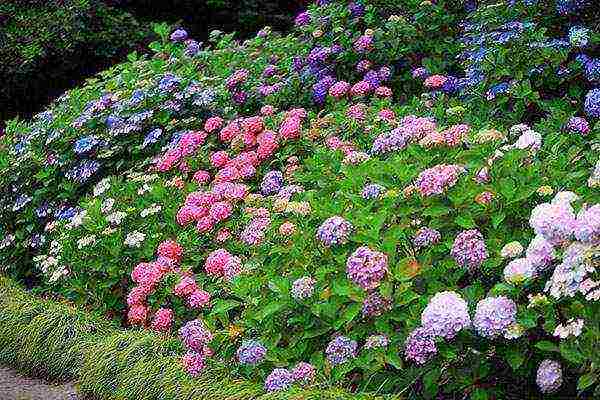 Hydrangea is a beautiful garden flower with fluffy multi-colored caps. They are represented by several types: by the type of shrubs up to 3 m high, small trees and vines that can braid a tree up to 30 m in height. The hydrangea will bloom from spring to frost, delighting with its globular inflorescences. However, there are species for which this time is shorter.
Hydrangea is a beautiful garden flower with fluffy multi-colored caps. They are represented by several types: by the type of shrubs up to 3 m high, small trees and vines that can braid a tree up to 30 m in height. The hydrangea will bloom from spring to frost, delighting with its globular inflorescences. However, there are species for which this time is shorter.
Hydrangea planting rules
 You can plant a hydrangea in early spring or fall. In this case, the first option will be preferable. For hydrangeas, you need to choose the right planting site. She prefers acidic soil with good moisture. With regard to lighting, these flowers can feel comfortable both in the sun and in partial shade.
You can plant a hydrangea in early spring or fall. In this case, the first option will be preferable. For hydrangeas, you need to choose the right planting site. She prefers acidic soil with good moisture. With regard to lighting, these flowers can feel comfortable both in the sun and in partial shade.
The whole planting process can be divided into several stages:
- It is necessary to dig a hole 40-50 cm deep and 40 cm in diameter. If the hydrangea bushes or outgrowths are small, you can make the hydrangea slightly smaller.
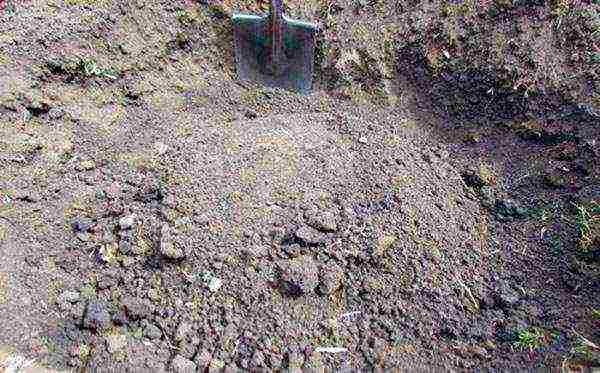
- Now you need to prepare a soil mixture consisting of fertile soil, humus and peat. It is advisable to add 50 g of mineral fertilizer to it. If possible, such a mixture is left in the pit for 15 to 30 days. If the soil at the planting site is rich and fertile, then the plant can be planted directly into it without prior preparation.
- The prepared seedling must be placed in the center of the planting pit so that its root collar is not deeply buried. Around the plant, you should carefully cover it with soil and tamp it so that the roots are well pressed and there is no void around them.
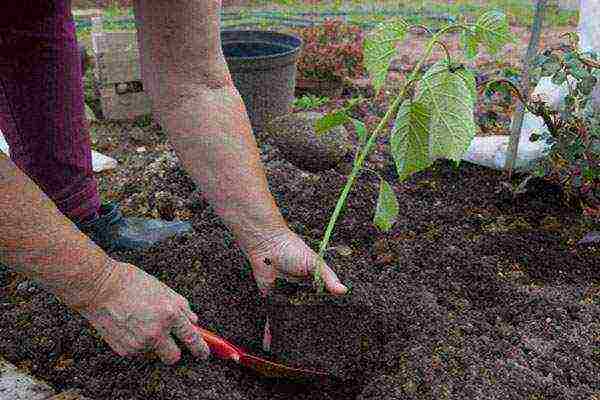
- The planted bush should be watered abundantly. It is advisable to additionally sprinkle the soil on top with sawdust, bark or peat.
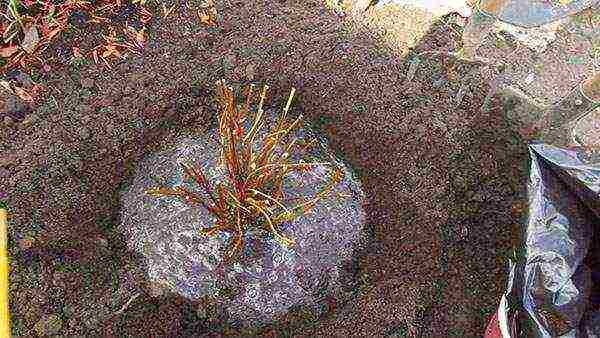
After planting a hydrangea bush, it is better to cover it from sunlight for a few days. This will allow the plant to take root faster. Hydrangea can be planted both singly and in groups. In this case, the distance between the bushes should be about 1 meter.
Basic rules for caring for hydrangea
Hydrangea care comes down primarily to proper watering, timely feeding, pruning and loosening. If you do everything right, the bushes will be lush, and the inflorescences will be large and bright.
Watering
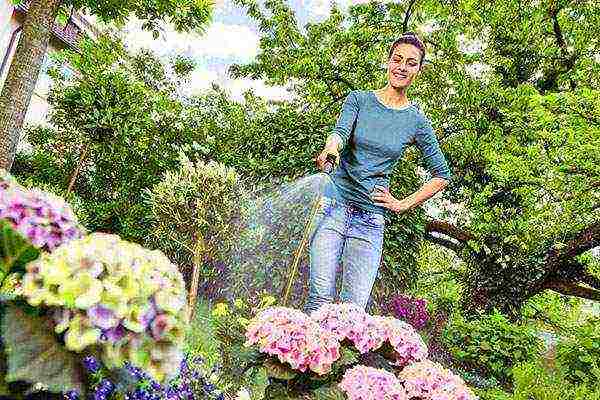 Hydrangea is a moisture-loving plant that requires frequent watering. It should be plentiful, 15 - 20 liters for each adult bush. In hot weather, this should be done once a week. In hot and dry summers, watering can be increased up to twice a week. In this case, you need to focus on the condition of the soil, given how quickly it absorbs moisture and dries out.
Hydrangea is a moisture-loving plant that requires frequent watering. It should be plentiful, 15 - 20 liters for each adult bush. In hot weather, this should be done once a week. In hot and dry summers, watering can be increased up to twice a week. In this case, you need to focus on the condition of the soil, given how quickly it absorbs moisture and dries out.
For watering, it is best to use settled soft water at room temperature. Periodically, you need to add a little potassium permanganate to it, which will prevent the appearance of rot. Water the hydrangea in the morning or evening, when it is not too hot.
Top dressing
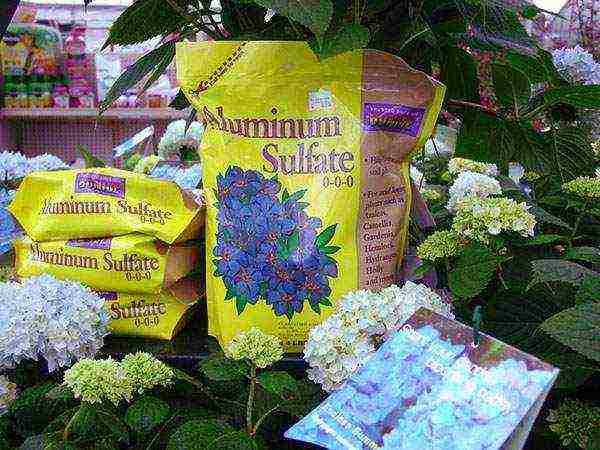 For good development and lush flowering, hydrangea needs to be fed. For this, both organic and mineral fertilizers are suitable. Their use is especially important during periods of intensive growth. You can buy ready-made fertilizers that are rich in magnesium and iron. Feeding in the form of a solution of poultry droppings with water in a ratio of 1:10 in combination with a mineral composition of 20 g of superphosphate, 10 g of nitrate and 10 g of urea has a good composition. You can use any slurry as a fertilizer, just observe the measure, otherwise the buds will be too large, which can cause fragile branches to break.
For good development and lush flowering, hydrangea needs to be fed. For this, both organic and mineral fertilizers are suitable. Their use is especially important during periods of intensive growth. You can buy ready-made fertilizers that are rich in magnesium and iron. Feeding in the form of a solution of poultry droppings with water in a ratio of 1:10 in combination with a mineral composition of 20 g of superphosphate, 10 g of nitrate and 10 g of urea has a good composition. You can use any slurry as a fertilizer, just observe the measure, otherwise the buds will be too large, which can cause fragile branches to break.
 It is necessary to fertilize hydrangea not only during planting, but periodically as it grows. The first such feeding should be done at the end of May. It should be repeated after two weeks. You can fertilize flowers throughout the summer, but in August it is advisable to stop feeding so that the shoots can become woody for winter.
It is necessary to fertilize hydrangea not only during planting, but periodically as it grows. The first such feeding should be done at the end of May. It should be repeated after two weeks. You can fertilize flowers throughout the summer, but in August it is advisable to stop feeding so that the shoots can become woody for winter.
Mulching
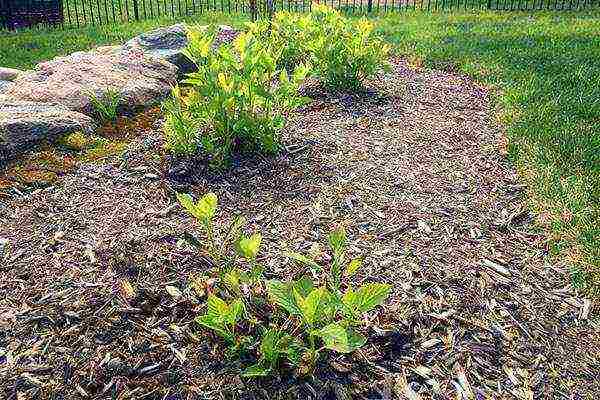 Thanks to the mulching of the trunk circle, the roots of the hydrangea will be protected from overheating and rapid growth of weeds. You must first make an organic mulch consisting of wood chips or peat. It should be scattered evenly around the bush. This will help make the soil more acidic, which is what hydrangeas need. This mulch will gradually become part of the soil.
Thanks to the mulching of the trunk circle, the roots of the hydrangea will be protected from overheating and rapid growth of weeds. You must first make an organic mulch consisting of wood chips or peat. It should be scattered evenly around the bush. This will help make the soil more acidic, which is what hydrangeas need. This mulch will gradually become part of the soil.
It is best to apply mulch under the bushes in late spring, when the soil is well warmed up. Mulching is also possible in late autumn, when temperatures are below zero. Periodically, the shrubs need to be loosened so that the soil is more moisture permeable.
Pruning
 Pruning is done on plants that are 3 to 4 years old. This should be done in early spring - before sap flow and budding begin. If carried out too early, the cuttings will be unsuitable for further rooting, and if it is too late, the plant may die. This is why it is important to prune when the buds are just starting to swell.
Pruning is done on plants that are 3 to 4 years old. This should be done in early spring - before sap flow and budding begin. If carried out too early, the cuttings will be unsuitable for further rooting, and if it is too late, the plant may die. This is why it is important to prune when the buds are just starting to swell.
When pruning in mature plants, cut 3/4 of the height of each shoot with a pruning shear. In this case, 2 - 3 pairs of kidneys should remain on them. Old bushes can be renewed at the root. Everything will depend on the condition of the bush or tree. You need to cut off old or frozen shoots. During pruning, you can form a beautiful small tree with a certain shape. In the first year of the hydrangea's growth, its flowers should be removed. this will encourage more abundant flowering next year.
Preparing hydrangeas for winter
 Hydrangea is a thermophilic plant, so it must be protected in the winter season. Young shoots and insufficiently winter-hardy varieties need special protection. If the bush is very young, you can simply cover it from above with earth, fallen leaves or sawdust. Older plants must be bent to the ground and covered with roofing material or lutrasil. To prevent the wind from blowing it away, you need to press down the covering material with bricks.
Hydrangea is a thermophilic plant, so it must be protected in the winter season. Young shoots and insufficiently winter-hardy varieties need special protection. If the bush is very young, you can simply cover it from above with earth, fallen leaves or sawdust. Older plants must be bent to the ground and covered with roofing material or lutrasil. To prevent the wind from blowing it away, you need to press down the covering material with bricks.
Mature bushes require more cover. We must try not to break them.The bush should be tied up, and then covered with spunbond or lutrasil, after which a frame of metal mesh or other materials at hand can be built around it. It should be about 20-25 cm away from the bush. The free space must be filled with dry foliage. Such an insulated frame will protect the hydrangea well even in severe frosts. You can remove it in the spring, when there is a stable above zero temperature.
Reproduction of hydrangea
Hydrangea is propagated in several ways:
- Cuttings. Reproduction in this way is best done in mid-spring or early summer. One-year lateral shoots must be used as blanks. They should be about 10-12 cm long. Cuttings should be cut at right angles. From below they need to remove the leaves.
 To root cuttings, you need to prepare the soil. For this, a light substrate is used, consisting of fertile soil, peat and sand.
To root cuttings, you need to prepare the soil. For this, a light substrate is used, consisting of fertile soil, peat and sand.  You need to plant cuttings in it, placing them at an angle. Each individual plant should be 5 cm apart. It will take about a month to root the shoots.
You need to plant cuttings in it, placing them at an angle. Each individual plant should be 5 cm apart. It will take about a month to root the shoots.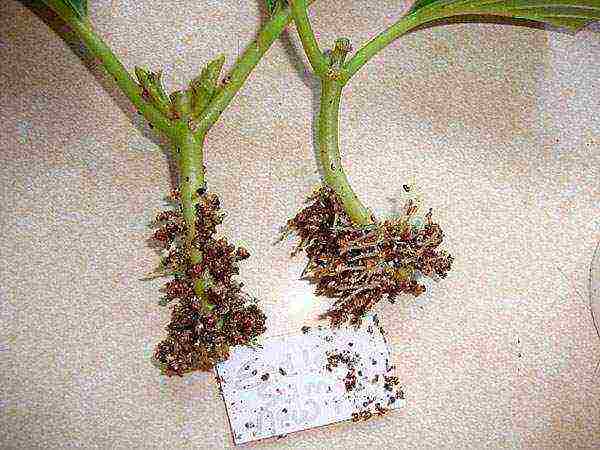
- By dividing the bush. It can be propagated both in spring and autumn. To do this, the plant must be dug up and divided into several parts so that each individual bush has a bud of renewal. After that, the plant is simply planted in the prepared places.

- Layers. For the propagation of hydrangea by layering, you need to select young shoots, which will not be more than a year old. They should be bent to the ground and dug in so that a small top of 20 cm remains on top. The next year, the shoot will take root and it can be separated from the main bush and planted in another place.
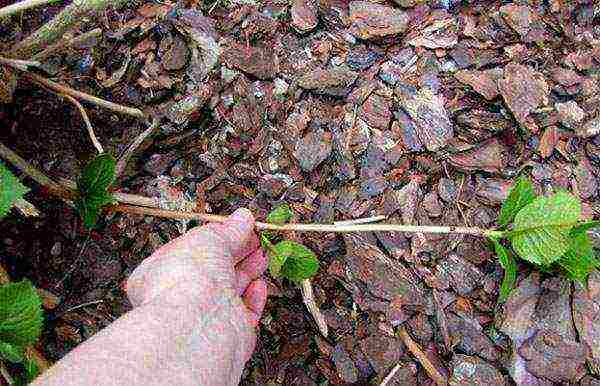
- Seeds. This is a rather troublesome process, so this breeding method is rarely used. The seeds need to be grown at home. To do this, they are planted in pots and only lightly sprinkled with sand. They need to be watered and fertilized frequently as they grow.
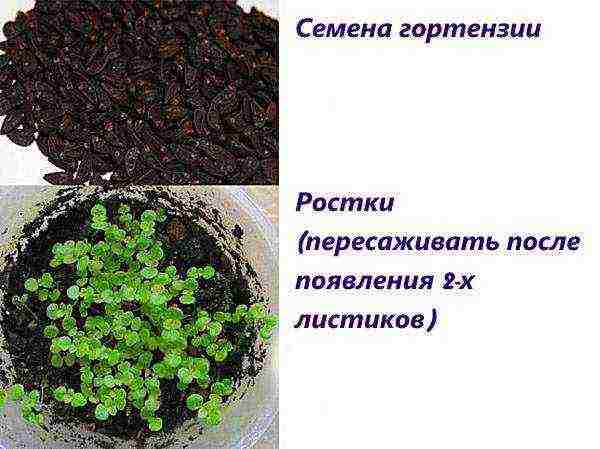
Popular types of hydrangea
Before planting a hydrangea, you need to decide on the choice of a suitable type. Each of them has its own growing characteristics, which must be taken into account when planting and caring for. The most popular among gardeners: Large-leaved hydrangea, Paniculata hydrangea, Stalked hydrangea, Treelike hydrangea.
Large-leaved hydrangea (Hydrangea macrophylla)
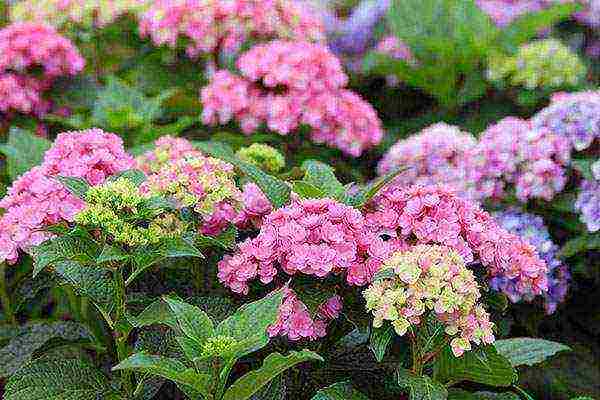 It will delight with flowering in July-August. This hydrangea has bright, dense foliage. The shoots of the current year look herbaceous, which is why the plant has a low cold resistance. Flowers have an umbrella shape. They can have different colors depending on the variety, the intensity of which depends on the acidity of the soil. The more acidic it is, the brighter the hydrangea will be. The height of the bush reaches up to 2 m.
It will delight with flowering in July-August. This hydrangea has bright, dense foliage. The shoots of the current year look herbaceous, which is why the plant has a low cold resistance. Flowers have an umbrella shape. They can have different colors depending on the variety, the intensity of which depends on the acidity of the soil. The more acidic it is, the brighter the hydrangea will be. The height of the bush reaches up to 2 m.
Hydrangea paniculata (Hydrangea paniculata)
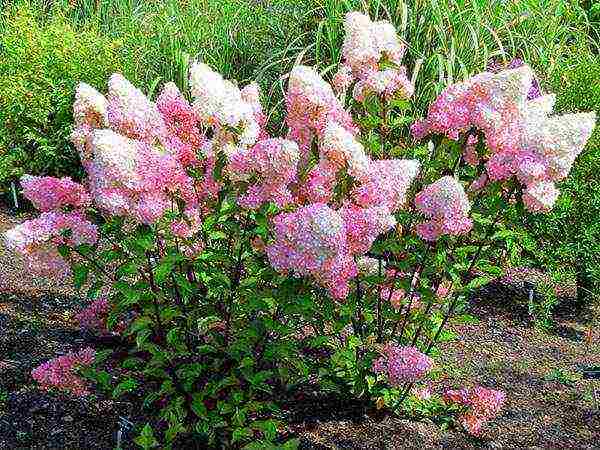 Blooms from mid-summer until the onset of cold weather. Inflorescences of this type have a pyramidal shape. They can reach a length of up to 30 cm. Panicle hydrangea grows in the form of a shrub, which can reach a height of 5 m or in the form of a small tree up to 10 m. This species is considered more frost-resistant and unpretentious.
Blooms from mid-summer until the onset of cold weather. Inflorescences of this type have a pyramidal shape. They can reach a length of up to 30 cm. Panicle hydrangea grows in the form of a shrub, which can reach a height of 5 m or in the form of a small tree up to 10 m. This species is considered more frost-resistant and unpretentious.
Stalked hydrangea (Hydrangea petiolaris)
 It is a shrub vine. It will require an additional support to which it will be attached with air suction cups. In length, it grows up to 25 m. This is a suitable species for planting near arches and arbors. Inflorescences have a corymbose shape up to 25 cm in size.
It is a shrub vine. It will require an additional support to which it will be attached with air suction cups. In length, it grows up to 25 m. This is a suitable species for planting near arches and arbors. Inflorescences have a corymbose shape up to 25 cm in size.
Hydrangea tree (Hydrangea arborescens)
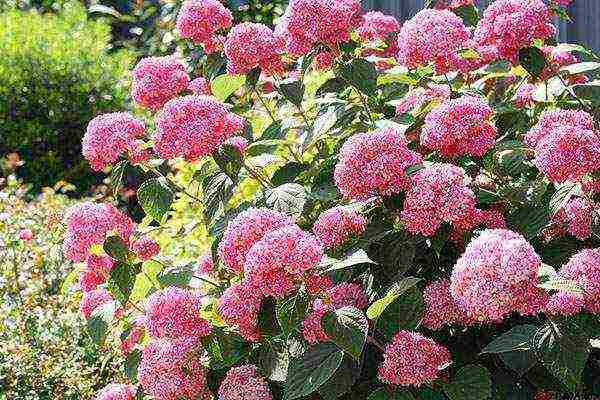 It grows up to 3 meters in height. The flowers are predominantly white or cream in color. There are several varieties of this species, differing in different colors. In winter, the plant can freeze slightly, so it must be carefully wrapped. In April, the bushes need to be heavily pruned. The flowers grow in large fluffy inflorescences.
It grows up to 3 meters in height. The flowers are predominantly white or cream in color. There are several varieties of this species, differing in different colors. In winter, the plant can freeze slightly, so it must be carefully wrapped. In April, the bushes need to be heavily pruned. The flowers grow in large fluffy inflorescences.
Ground cover hydrangea (Hydrangea heteromalla)
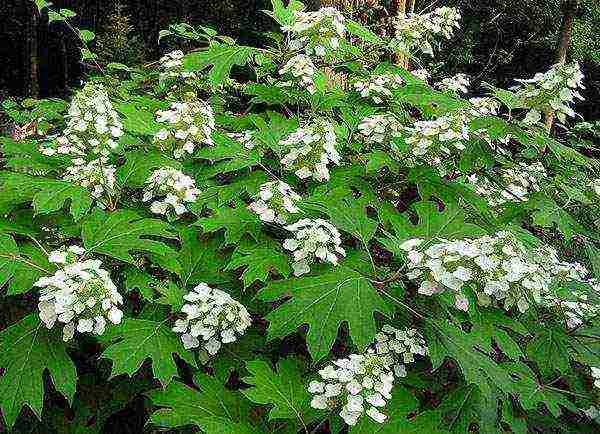 It is also called the Bretschneider hydrangea.This species is considered hardy and unpretentious. The bush reaches 2 - 3 m in height. The inflorescences are corymbose. At first they are white, and at the end of flowering they turn pink. Such a hydrangea blooms in the middle of summer.
It is also called the Bretschneider hydrangea.This species is considered hardy and unpretentious. The bush reaches 2 - 3 m in height. The inflorescences are corymbose. At first they are white, and at the end of flowering they turn pink. Such a hydrangea blooms in the middle of summer.
Recommendations for planting and caring for hydrangea in the garden - video
One of the most beautiful ornamental shrubs is the large-leaved hydrangea, planting and caring for which can be performed in different conditions. This plant grows well in the open field and in a pot-container.
Large-leaved hydrangea: planting and care in pots
Large-leaved hydrangea can be bought at any time of the year in a container with a small clod of earth. After purchasing the plant, it is transplanted into a large container of 30-40 liters. Ready soil or a self-prepared substrate is poured into the pot, consisting of well-rotted plant and organic residues, peat, loose leafy earth and sifted river sand.
If there is a swamp near the garden area, then you can bring some potting soil from there. Large-leaved hydrangea is especially responsive to the increased acidity of the soil. The acquired young plant is planted in a new pot along with a clod of earth, the soil is well compacted and watered abundantly.
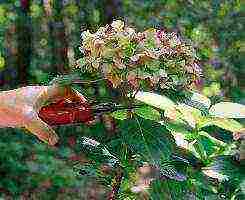 If these measures are taken in the fall, then after the foliage is dropped, the plant is cut off and placed in a cool place: in a cellar or a cold corridor, where the temperature does not drop below + 1-2 degrees. In February, the pots are rearranged on the windowsill in the southern part of the apartment and they begin to water regularly, 2-3 times a week and periodically feed the plant with complex additives.
If these measures are taken in the fall, then after the foliage is dropped, the plant is cut off and placed in a cool place: in a cellar or a cold corridor, where the temperature does not drop below + 1-2 degrees. In February, the pots are rearranged on the windowsill in the southern part of the apartment and they begin to water regularly, 2-3 times a week and periodically feed the plant with complex additives.
Indoors, large-leaved hydrangea can grow throughout the warm season. But it is better to put it on the balcony or, if there is a summer cottage, take it there and place it on the terrace, veranda or in the gazebo. If desired, the bush is transplanted into open ground in May, where it grows all summer, and in the fall it is again transferred to a container. This is what gardeners of the northern regions and the Moscow region do, where there are severe frosts.
Large-leaved hydrangea in the open field
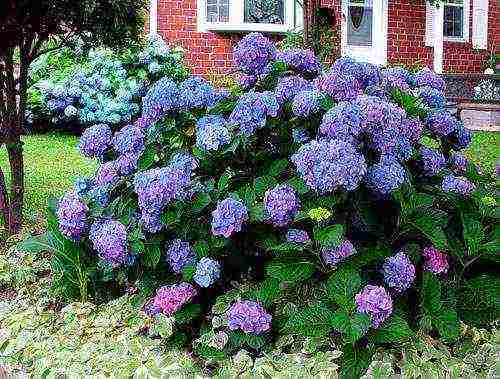 Residents of the southern regions can grow a beautiful hydrangea outdoors. For this, a young plant is planted in light partial shade, for example, near the wall of a house or near another building.
Residents of the southern regions can grow a beautiful hydrangea outdoors. For this, a young plant is planted in light partial shade, for example, near the wall of a house or near another building.
In order for the large-leaved hydrangea to bloom magnificently, it is not recommended to place it next to fruit trees, which will take all the moisture from the soil for themselves. The name of the plant "hydrangea", or "vessel with water" indicates that the abundance of water is very important for it. With a lack of it, greens and flowers will look faded and unattractive.
The next day after watering, the ground around the bush must be loosened to a depth of 5 cm.To avoid rapid evaporation of moisture, a thick layer of mulch mixture is poured: peat, sawdust, dry last year's leaves or fresh cut grass without seeds.
During the summer, an aqueous solution of complex fertilizer is applied 3-4 times under the root.
A feature of large-leaved hydrangea is the ability to artificially change the color of inflorescences. To obtain flowers with unusual colors, oxidizing agents are added to the soil once every 2 weeks: ammonia-potassium or aluminum-potassium alum, 3-5 pieces per 1 liter of water. One adult plant requires 2 liters of solution. In some cases, the plants are instead watered with diluted whey or water infused with rusty nails, pieces of iron. This technique also allows you to get multi-colored balls.
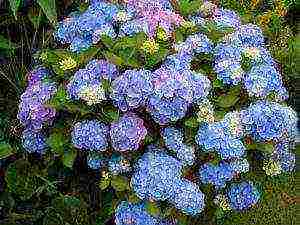 Garden or large-leaved hydrangea is a gorgeous shrub in every sense. Despite the fact that this plant is initially not very hardy, the fashion for it has embraced our gardens as well. The magnificent caps of the inflorescences with unique shades of color, the luxurious leaves and silhouettes of this queen among the hydrangas are enchanting.And only after planting a bush or two of large-leaved hydrangea in their garden, many gardeners discover all the "pitfalls". This hydrangea, the most difficult to grow, requires systemic care and attention, the most careful selection of conditions and is generally quite capricious.
Garden or large-leaved hydrangea is a gorgeous shrub in every sense. Despite the fact that this plant is initially not very hardy, the fashion for it has embraced our gardens as well. The magnificent caps of the inflorescences with unique shades of color, the luxurious leaves and silhouettes of this queen among the hydrangas are enchanting.And only after planting a bush or two of large-leaved hydrangea in their garden, many gardeners discover all the "pitfalls". This hydrangea, the most difficult to grow, requires systemic care and attention, the most careful selection of conditions and is generally quite capricious.
Large-leaved hydrangea, or garden (Hydrangea macrophylla) is a highly decorative and fast-growing type of hydrangea native to Japan and China. The maximum height in a region with severe winters is limited to 1-2 m.This species has erect shoots, ovoid, large, bright green leaves and flat wide inflorescences with a diameter of up to 15 cm and a height of up to 10 cm, consisting of fruiting lilac or blue and large pink, with irregular bright strokes, reaching up to 3.5 cm in diameter, sterile flowers. Hydrangea inflorescences, the flowering of which starts in July, remain highly decorative until next spring: they dry out, but still remain very attractive.
Large-leaved hydrangeas, the fashion for which came to us from the West, so captivating in tubs and pots, so unique in their beauty for their almost spherical dense inflorescences and bright foliage - shrubs are still capricious and unadapted to the harsh climate. But this does not prevent them from growing even in regions with harsh winters. And although these beauties need special care and protection for the winter, their beauty, nevertheless, is unmatched. And it doesn't matter if you decide to transplant a potted hydrangea into the garden or originally purchased a garden plant - the principles of growing and caring for the shrub will still be the same. The main difficulty in growing large-leaved hydrangeas is associated with the need to preserve last year's shoots, on which this type of hydrangea blooms, during a long and harsh winter, not only without freezing, but also without damping off.
Choosing the right variety is a key success factor in growing large-leaved hydrangeas. This plant has more winter-hardy and less hardy varieties that can only winter indoors. The declared frost resistance of this type of hydrangea is up to -18 degrees, typical only for varieties adapted to the harsh climate and mainly modern ones. When choosing hydrangeas, you should give preference to plants not according to the degree of their decorativeness, but according to the factor of adaptability to your climate - the plants of local garden centers and nurseries. Imported large-leaved hydrangeas are more likely to cause disappointment. Be sure to check if the variety has been tested in your area or is grown in a climate similar to yours. When choosing a variety, you should pay attention to one more very important factor: remontability or common cultivar. Repairing varieties, to which the vast majority of modern macrophylls belong, are hydrangeas, which can boast not only a variety of colors, but also the ability to bloom both on last year's and on young shoots. Such hydrangeas are guaranteed to bloom: even if something fails or winter protection is not enough, young branches will still give at least a few inflorescences.
Hydrangea macrophylla is grown differently from other types of hydrangeas, including treelike and paniculate. If other species have much more in common than excellent in the requirements for care and selection of conditions, then the large-leaved hydrangea requires a special approach to itself. Large-leaved hydrangeas should be bought only in containers or pots: seedlings with an open root system do not take root well and should not even be experimented with in regions with harsh winters (injuries received by the root system will not allow the plant to fully adapt and grow the root system sufficient for to withstand the winter even with shelter).
Conditions required for large-leaved hydrangea
Despite the status of shade-tolerant shrubs, inherent in all hydrangeas without exception, macrophylls do not belong to such. Even in southern regions with mild winters, this plant can be planted only in partial shade, and not in the shade, and in regions with severe winters, plants should be classified as light-loving. But when choosing a place for a large-leaved hydrangea, you should not rush to plant it on hot sunny areas, protecting it from midday and lunch rays. So that the large-leaved hydrangea does not suffer from heat and overheating of the roots, the plants are planted in a place where they will not be illuminated by the daytime, but by the morning or evening sun (but not less than 6 hours a day). Ordinary sunny areas will lead to the fact that in summer the leaves and inflorescences of the bush will wither and wither every day, and the latter may not recover even at night.
When choosing a place, it is worth considering the location in relation to trees and shrubs. Despite the fact that in most landscape projects hydrangeas can be seen under the trees, planting macrophylls in such a company is still not a good idea. Hydrangea is moisture-loving and under woody ones it can suffer from a lack of moisture, which will be pulled from the ground by giants.
Planting large-leaved hydrangeas
Planting macrophylls requires great care and careful preparation. The main attention should be paid to the preparation of the site and the soil mixture, which will be filled with the planting pit.
The optimal planting time in regions with severe winters (including in the middle lane) is spring. Planting hydrangeas is carried out as soon as the weather permits, the soil will not only thaw, but also warm up, and the threat of severe frosts will pass.
For large-leaved hydrangea, the recommended planting distance is about 1 m.
Hydrangea is not simply covered with soil removed during the digging of a hole, but a special soil mixture is prepared in which the roots adapt and germinate faster. Peat, humus, coniferous soil are added to the garden soil in equal shares, preparing a loose and super nutritious soil mixture. The garden soil removed from the hole, in turn, can be replaced with a mixture in equal proportions of sod, leafy soil and sand. But the key point is to determine the acidity of the soil, which, in turn, will provide the color of the inflorescences. If you want to grow those very blue, blue or purple hydrangeas (you can get them only from varieties with a pink or red color, but not from white-flowered hydrangeas), then you need to prepare in advance such a soil that will provide the original high acidity. For blue hydrangeas, the pH should be between 5.0 and 5.5. For hydrangeas with white, pink and red inflorescences, the permissible value is from 6.0 to 6.2 (in acidic soil, the color of non-white varieties will change to lilac or blue). In any case, large-leaved hydrangeas should not be planted in soil with a calcareous reaction (maximum permissible pH value is 6.4). If you want to get blue or lilac colors, then you need to add aluminum sulfate to the soil. At the same time, if the soil is changed specifically to obtain blue hydrangeas, it must be remembered that such an addition is only the first step. In the future, it will be possible to save the colors only with proper watering and fertilization. In addition to the acidifying additive, a full portion of complex mineral fertilizers is also applied to the soil. Today, the addition of hydrogel has become fashionable, which allows you to more effectively retain moisture.
The size of the planting pit should correspond to the size of the root ball of a large-leaved hydrangea: about 35 cm deep and wide for small bushes in small containers and half-meter holes for larger specimens. Preparing the landing pit will also require additional tweaks. To avoid the risk of water stagnation even on ordinary clay soils, improve water and air permeability, create an optimal environment at the bottom of the planting pits, you need to lay a drainage layer (expanded clay or pebbles, but not crushed stone).
Before planting, the upper free layer of the substrate is carefully removed from the container (usually it is quite dirty), and the plant is watered abundantly for at least a few hours. When taking out a hydrangea, you need to be very careful and try not to destroy the earthen lump.In a cramped container or pot, strong young roots tend to curl around the perimeter of the earthen coma, as if entangling the substrate. They need to be straightened, straightened carefully, without injuring the small roots. A thin layer of soil is poured at the bottom of the hole and a small mound is created. A hydrangea is placed on it, straightening long roots. Then the seedling is carefully covered with the prepared soil mixture, carefully tamping the soil and gently compacting it around the root ball. When planting, you need to ensure that the depth of the root collar does not change.
Planting large-leaved hydrangea is completed with abundant watering and mulching: the trunk circle is covered with a layer of peat or a mixture of peat and compost with a height of 7 to 10 cm.
Large-leaved hydrangea care
Humidity and watering requirements
Large-leaved hydrangeas, like any other species of this shrub, are not accidentally named hydrangeas. But if some types of hydrangeas are content only with watering in a drought, then the large-leaved beauty needs a more careful approach. For this hydrangea, the soil in the trunk circle must be kept constantly moist. Since uniform moisture can be achieved only by systemic irrigation, the macrophylla hydrangea is watered regularly (at least once a month), teaching procedures in drought and heat (the optimal strategy is 1 watering per week). For each hydrangea bush, 20-25 liters of water are used, deeply soaking the soil under the plant. Hydrangeas are watered at the root, so that both the garden soil and the lump of earth that was saved during planting are saturated.
Shrubs need watering not only in spring and summer, but also in autumn. Lack of moisture while preparing for winter can cause severe damage to the plant. But excessive humidity in autumn is also very dangerous. If the weather is rainy and there is a lot of precipitation, then the large-leaved hydrangea is protected from getting wet, because it should go under the shelter with low soil moisture and dried crown.
You can simplify the watering process by taking care of mulching: it will more effectively retain moisture and protect the root system from overheating. For mulching garden hydrangeas, materials are used that play the role of an acidifying additive - coniferous litter, coniferous soil or pine bark. Refill mulch 2-3 times per season.
The characteristics of the water for irrigating hydrangeas are of great importance. For blue and lilac hydrangeas, watering can only be carried out with soft or acidified water, the pH value of which does not exceed 5.5. But for any other hydrangeas, it is preferable to use soft or rain, warm, settled water.
For large-leaved hydrangeas, drip irrigation systems can be installed that effectively direct water to the roots and maintain a stable soil moisture.

